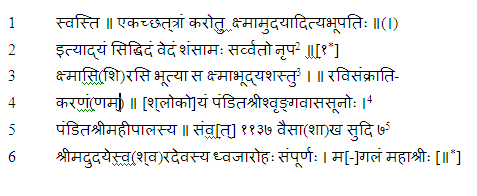|
The Indian Analyst
|
North Indian Inscriptions |
INSCRIPTIONS OF THE PARAMARAS OF MALWA above. The last line of the record expresses the purpose, in which the temple is mentioned by the name Udayēśvaradēva, evidently after the name of its constructor. And with the expressions ‘auspiciousness, great fortune’, the record comes to an end . ...As stated above, the importance of the inscription lies in the fact that it supplies the earliest known date for the king Udayāditya, who, according to the praśasti found at the same place, rescued the earth (i.e., the Paramāra kingdom), as the primeval boar, the significance of which will be seen in its proper place. The inscription does not contain any geographical name.
TEXT[1]
No. 20 ; PLATE XXI-B ...THIS inscription was brought to light by the late Mr. K. K. Lele, the Superintendent of Archaeology, in the former State of Dhār, by editing it in the Annals of the Bhandarkar Institute, Vol. IV (1921-22), pp. 99 ff., with a facsimile by hand-drawing. The record is edited here from the same facsimile and also from my personal examination of the original. The inscription is on pedestal of a Dēvī image which is stated to have been found in the Dēvī tank at Dhār, where it remained imbedded for several years. Its original find-spot is not known, but from Lele’s writings we know that it was probably discovered by Lālā Bhavānī Shankar, who was an officer in the Dhār State, some time in the latter half of the last century. Lele also managed to secure possession of the image which is now deposited in the residence of his successor at Dhar. ...The image is about 57.15 cms. tall and about 26.7 cms. in breadth. It is cut out of hard white stone resembling marble, and represents a goddess in a standing posture, profusely ornamented and wearing a crown. She has four hands holding prayerful symbols, and seems to be immersed in deep meditation. On the panel above are the images of Brahmā and Vishṇu on her proper right, and on either side of her stands a female figure with a fly-whisk in her hand, and below each of them is another female figure in a prayerful mood. I take the image as representing Pārvatī in penance, for the reasons given below in the text. ...As already stated above, the inscription is incised on the pedestal of this statue. It consists of
two lines, covering a space measuring about 20 cms. broad by 10 cms. high. The average size of the letters is about 2 cms.
[1] From the original and an impression.
|
||||||||||||||||||||||||||||||||||||||||||||||||||||||||||||||||||||||||||||||||||||||
| > |
|
>
|










